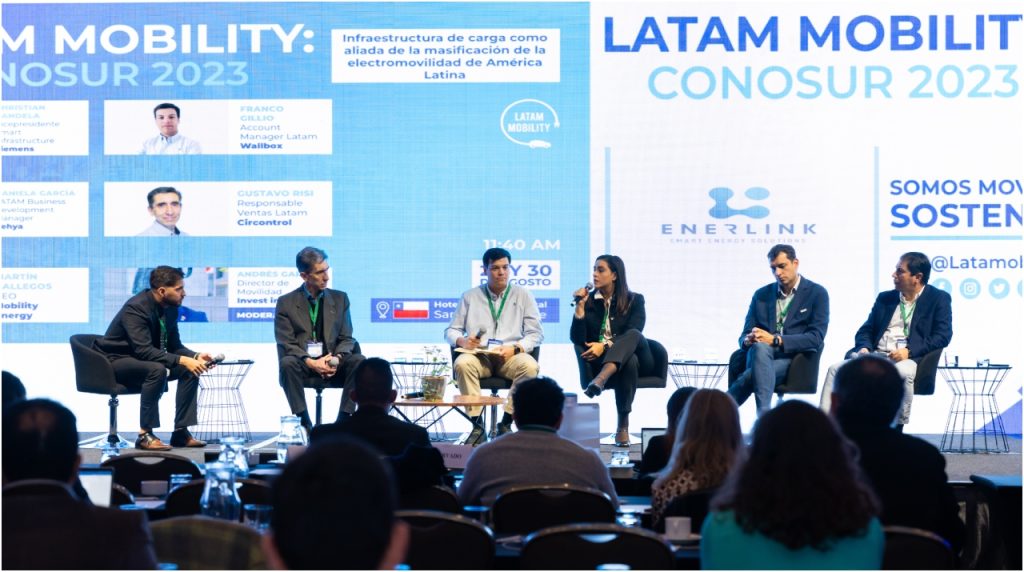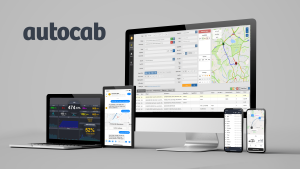Within the framework of Latam Mobility Conosur Chile 2023, an important panel discussion was held for the future of mobility in Latin America: “Charging Infrastructure as an Ally for Electromobility Massification.”
Moderated by Andrés García, Mobility Director of Invest in Latam, it brought together leading experts committed to the development of electric mobility in the region.
Christian Candela, Vice President of Smart Infrastructure at Siemens; Franco Gillio Lara, Account Manager Latam at Wallbox; Daniela García, LATAM Business Development Manager at Vehya; Gustavo Risi, Latin America Sales Manager at Circontrol; and Martín Gallegos, CEO of Mobility Energy, joined together to share knowledge and experiences in favor of the development of a sustainable mobility ecosystem.
Throughout the discussion, they explored opportunities and challenges facing Latin America as it moves towards the massification of electromobility, highlighting the crucial role that charging infrastructure plays in this journey towards a greener and more efficient future.
Beyond Sales
Daniela Garcia, Vehya’s Executive, shared her highlights of the company’s mission and approach to electromobility, presented as a Marketplace that seeks to promote electrification and develop integrated solutions that encompass products and services.
Now, what distinguishes Vehya is its commitment to the sale of electric chargers and the installation and maintenance process of these devices.
Garcia emphasizes that it is not enough to have electric chargers available; it is essential to ensure their proper functioning and to be an active part of the ever-growing electric charging infrastructure ecosystem in Latin America.
“The company, with American roots, has been working on this mission for two years and has already made a significant impact in Canada, Mexico and Brazil, where we have carried out specific projects related to the electrification of mobility,” assures Garcia.
Related content: ACERA, Acen, Adelat, Copec Voltex and Chile’s National Electric Coordinator Highlight Energy Sector Opportunities for Sustainable Mobility
Now, when talking about charging infrastructure in Latin America, it is common for the conversation to focus mainly on public infrastructure, i.e., the network of charging stations that allow electric vehicles to conveniently and accessibly recharge their batteries in urban spaces and highways.
However, Daniela Garcia points out that there is a significant opportunity in the residential segment that often goes unnoticed but has great potential for growth.
In contrast to Europe, where residential charging is a viable and common option, in Latin America there are still many unanswered questions in this area.
“Residential charging infrastructure could give rise to a new electric charging consumption model, allowing electric vehicle owners to conveniently charge their cars at home,” she said.
On the other hand, she commented that Vehya is focused on providing a comprehensive platform that offers charging products and installation services with financing options with transparent project management.

The goal is to make residential charging more accessible and understandable for consumers, while adapting to the particularities of each project.
In that sense, García emphasized that as electromobility expands in Chile, Latin America and the world, it is essential to have flexible solutions that can adapt to the needs of millions of people who wish to incorporate electromobility into their daily lives.
Three Innovation Principles
Franco Gillio Lara, Wallbox Representative, pointed out his company’s specialization in the manufacture and development of energy management and charging systems for electric vehicles, with a global presence, operating in more than 100 countries with a strong focus on Latin America, where they cover 26 nations.
In addition, they have four factories in different parts of the world, including Europe, China and recently in the United States, in Texas.
In fact, in just over a month, Wallbox has sold more than 500,000 electric chargers, and through its hardware and software, they have managed more than 45 million charging sessions, which would amount to 4 billion kilometers traveled in electric vehicles.
In this context, Wallbox is guided by three innovation principles when developing its solutions. First, they seek to make their solutions simple, easy to understand, intuitive and intelligent.
In addition, they always have the end user in mind, working on solving real problems that people face in their daily lives.
“The context of energy transition and emissions reduction is critical for Wallbox. 39% of greenhouse gas emissions come from the transportation industry, raising the urgent need to adopt electric vehicles and move towards an energy transition in the region”, he said.
Now, with regard to Latin America, Gillio Lara sees significant opportunities, such as the world’s largest electric bus fleet outside China, which is located in Chile.
He also mentioned the energy efficiency law that will come into force in 2024 to boost the adoption of electric vehicles in the region. In addition, the presence of strategic minerals such as lithium and copper in the region makes transportation electrification even more relevant.
“Wallbox sees charging infrastructure and the adoption of electric vehicles as an important need and a growing demand in the region. The company is committed to providing innovative and flexible solutions to support the electrification of transportation in Latin America and around the world, helping to reduce greenhouse gas emissions and moving towards a more sustainable future in mobility,” Lara continued.
Partnership for Development
Gustavo Risi, Circontrol Executive, a company dedicated exclusively to the manufacture of chargers for electric vehicles with this area as its main focus.
“The importance of charging infrastructure is undeniable, as it serves as a convergence point in the electric vehicle charging system, which includes the electric vehicle at one end and the power grid at the other,” commented Risi.
In many cases, charging is done using alternating current, which can be a relatively slow process. However, the need for multiple charging points in public places is clear.
“This would lessen the main concern of electric vehicle owners: the availability of chargers. In this context, DC chargers present themselves as a great opportunity in the market,” he said.

Circontrol thus offers chargers with capacities of up to 400 kilowatts, power that exceeds the needs of most electric vehicles available today.
However, they face a major challenge: the cost of setting up an electric charging station, also known as an “electrolinera”.
“This cost includes the acquisition of the charger and investment in infrastructure, the time required for implementation, and ongoing maintenance costs,” argues Risi.
Thus, government funding could play a crucial role in driving the expansion of charging infrastructure. Therefore, the main message Gustavo Risi wishes to convey is the importance of standardization of electric chargers.
This standardization refers to the adoption of standards and regulations that address aspects of electrical safety, personal safety and the interoperability of chargers with systems and platforms.
In addition, it seeks that governments and ministry authorities play an active role in creating an enabling environment for the development of electromobility.
“Currently, installing an electric vehicle charger is more expensive than setting up a traditional fueling station, and it is critical to address this disparity to encourage the adoption of electric vehicles,” he asserted.
Next Step after Charger
Martin Gallegos, a representative of Mobility Energy, a company that focuses primarily on industrial automation, electrical systems, charger manufacturing and other solutions related to electrical infrastructure, highlighted several key aspects of the company.
One of them was the ability to offer chargers along with end-to-end solutions that cover the entire process, from charger procurement to implementation and maintenance.
This comprehensive approach is crucial because, as Gallegos mentions, having a charger is only the first step; it is equally important to ensure its proper operation and availability over time.
Gallegos also highlighted the opportunity that exists in the electric mobility market. Despite the presence of important players in this field, some investment projects have had difficulties due to problems such as the high cost of recharging, lack of maintenance and lack of profitability.
“In countries like Uruguay, where the ratio of chargers to electric vehicles is eight to one, there is great potential to attract investors and turn charging infrastructure into a profitable business,” he says.
Thus, one of Mobility Energy’s main concerns is to guarantee the availability of connectors at all times. To this end, they constantly monitor chargers and offer the option of repurchasing chargers from customers if they are not available.
On the other hand, Gallegos also mentioned the challenges facing electric mobility in multi-dwelling and building environments.
Lack of adequate electrical infrastructure, as well as aesthetic and building board approval issues, can make it difficult to install chargers in these locations, which in turn limits charging accessibility for EV owners.
In addition, the high cost of electric vehicles and lack of incentives can be barriers to widespread adoption.
“While there are promising areas in electric mobility, there are significant challenges that need to be addressed for this transition to be successful,” he commented.
All of this prompts Mobility Energy to make the case for a comprehensive approach to electric mobility, addressing both charger manufacturing and associated infrastructure.
It also calls for attracting investors to drive the adoption of electric vehicles in order to address these specific challenges facing the installation of chargers in residential environments.
Electromobility Digitalization
Christian Candela, a Siemens representative, explained the company’s long history that goes back more than 175 years, mentioning a curious fact: the first project that Siemens developed in Chile approximately 95 years ago was related to electric transportation.
This historical fact served as an introduction to its focus on electromobility today. Siemens, as a company, has an extensive portfolio of products and solutions related to electromobility.
However, Candela emphasized that at the time they were concentrating their efforts in Latin America, specifically on solutions for depots, bus options and truck fleets.
Siemens has been investing in software development centers, including one in Argentina, to address the challenges of digitalization in electromobility and other areas.
Also, Candela addressed the complexity of electromobility, especially in terms of the choice of connectors, load types and other project-specific factors.
He noted that there is no single answer due to the multitude of variables involved, such as vehicle type, batteries, routes and electricity rates.
However, he assures that digitalization has greatly simplified modeling and the search for optimal solutions for each situation, to contribute to the viability and profitability of electromobility projects.
In this way, he highlighted the importance of digitization in electromobility and the ability to model and optimize complex systems to achieve efficient and cost-effective solutions, along with Siemens’ commitment to the development of specific solutions for Latin America and its interest in continuing to contribute to the advancement of electric mobility in the region.
With regard to Chile, he assured that the electric mobility industry highlights the focus and challenges faced in the Latin American market, being Siemens’ main market in the region, focused on driving this technology.
Fast and ultra-fast charging stands out as one of its main focuses to implement advanced technology that accelerates the charging of electric vehicles. “We are betting on electromobility and emerging technologies such as megawatt and wireless charging,” thus, exposing a long-term vision and significant investment in the future of electric mobility.
Finally, he closed with a call to action, emphasizing the importance of not missing the opportunities presented by the electric mobility market in Chile and the region in general.
“Other countries in the region, such as Brazil, have experienced impressive growth in this sector, indicating that Chile has significant potential in electric mobility, especially due to its renewable energy matrix,” he concluded.







